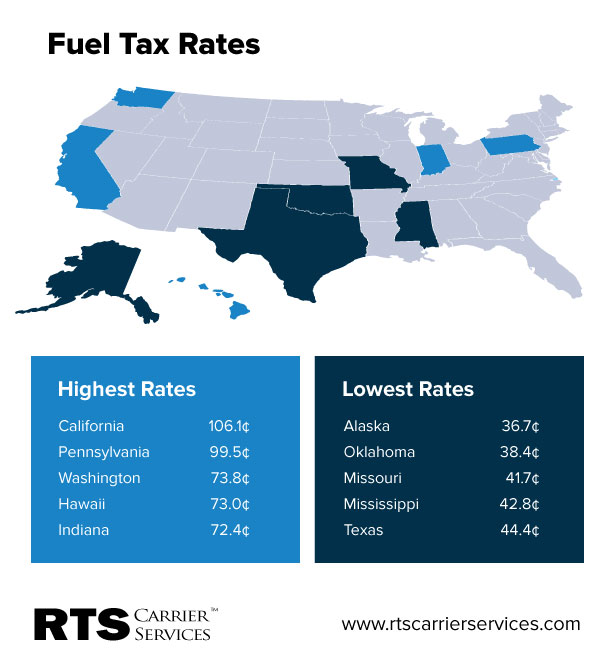

It is a well-known fact in the trucking industry that prices on diesel fuel are different in each state and often in each city. You may wonder why fuel prices vary so greatly by region or section of the country. Taxes are a major reason, but there are other factors as well.
Below are five key reasons why fuel prices can be vastly different from one stop to the next along your route:
Taxes
The biggest reason for the variance in fuel prices is that states tax gasoline at different rates. The rate often depends on how much money each state needs to raise in highway funding. Other issues like emissions regulations play a role as well.
According to the American Petroleum Institute, California this year has the highest rate at 106.1 cents per diesel gallon in combined state and federal taxes, followed by Pennsylvania at 99.5 cents. The state with the lowest tax rate is Alaska, at 36.7 cents per diesel gallon.
Emissions Standards
Refineries throughout the United States have to create more than 50 blends of gas to meet different city and state standards. Many cities and states require cleaner-burning fuel that emits less pollution into the environment. Producing so many different fuel grades adds operating cost to refineries and distributors. That cost is passed along to consumers and carriers.
Chicago has some of the strictest fuel emissions standards in the country and is often the city with the most expensive fuel prices. Cities with fewer restrictions like Charleston, S.C. often rank among areas in the U.S. with the cheapest fuel.
Crude Oil Prices
The price of fuel often reflects the level of oil production and the challenge in transporting crude oil from its drilling source to a refinery.
Today the oil drilling business is booming again, as U.S. oil production has surged to levels not seen since the early 1970s. Therefore, the price of crude oil is cheaper in states where it is produced or refined like Texas, North Dakota, Oklahoma and Louisiana. However, other areas of the country do not have access to that oil. Fuel prices and taxes tend to be steeper in areas like the Northeast and West Coast, which rely more on imported oil.
Pipelines
The nation’s pipeline infrastructure is the most effective way to transport crude oil from drillers to refineries. Until recently, the pipelines have lacked capacity to serve domestic fuel production, which contributes to the variances in diesel prices.
That challenge is now being addressed. In 2014, TransCanada Corp.’s Keystone Pipeline opened its south leg between Oklahoma and Texas. That leg can pump as much as 800,000 gallons of crude oil a day to refineries along the Gulf Coast. The pipeline has helped even out fuel prices between the country’s geographic center and the coasts.
TransCanada plans to begin work in 2019 on its new Keystone XL pipeline. The pipeline, which was first proposed in 2008, would ship 830,000 barrels of crude per day from Alberta, through Montana and South Dakota, to Nebraska. From there, it would connect with Keystone’s south leg, carrying crude to the Gulf Coast refineries.
Environmentalists and other groups strongly opposed the Keystone XL pipeline, so there could be more delays to its development. However, TransCanada has announced it has enough commitments from oil producers now to build the new pipeline.
Supply and Demand
Fuel prices are affected by various market factors that include refinery maintenance, the switch-over to summer blend gas and fluctuations in consumer demand. In most states, fuel consumption peaks in the summer travel months of July and August and is lower during the winter months.
Contact RTS today for information on our industry-leading fuel card program and maintenance perks.
Sources: American Petroleum Institute, The Washington Post, The Christian Science Monitor, USA Today, CNN.com